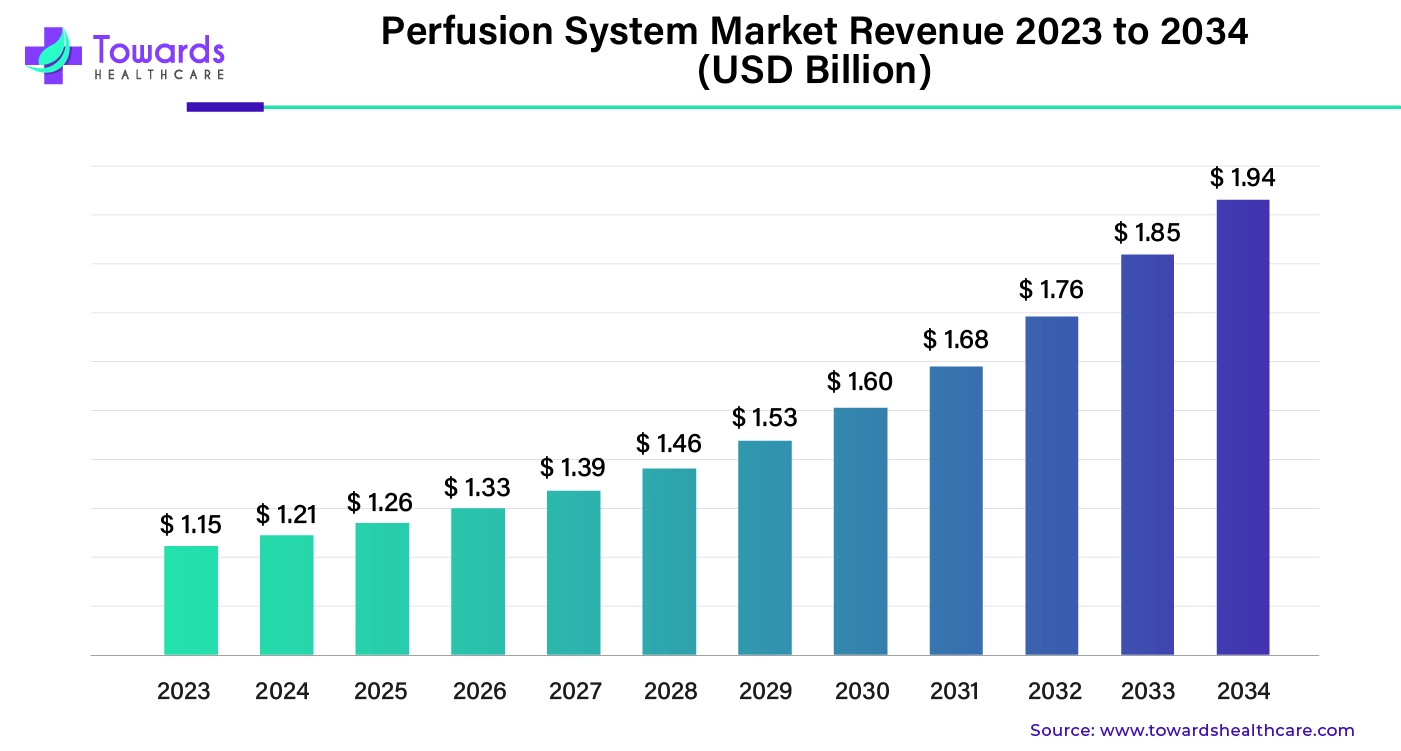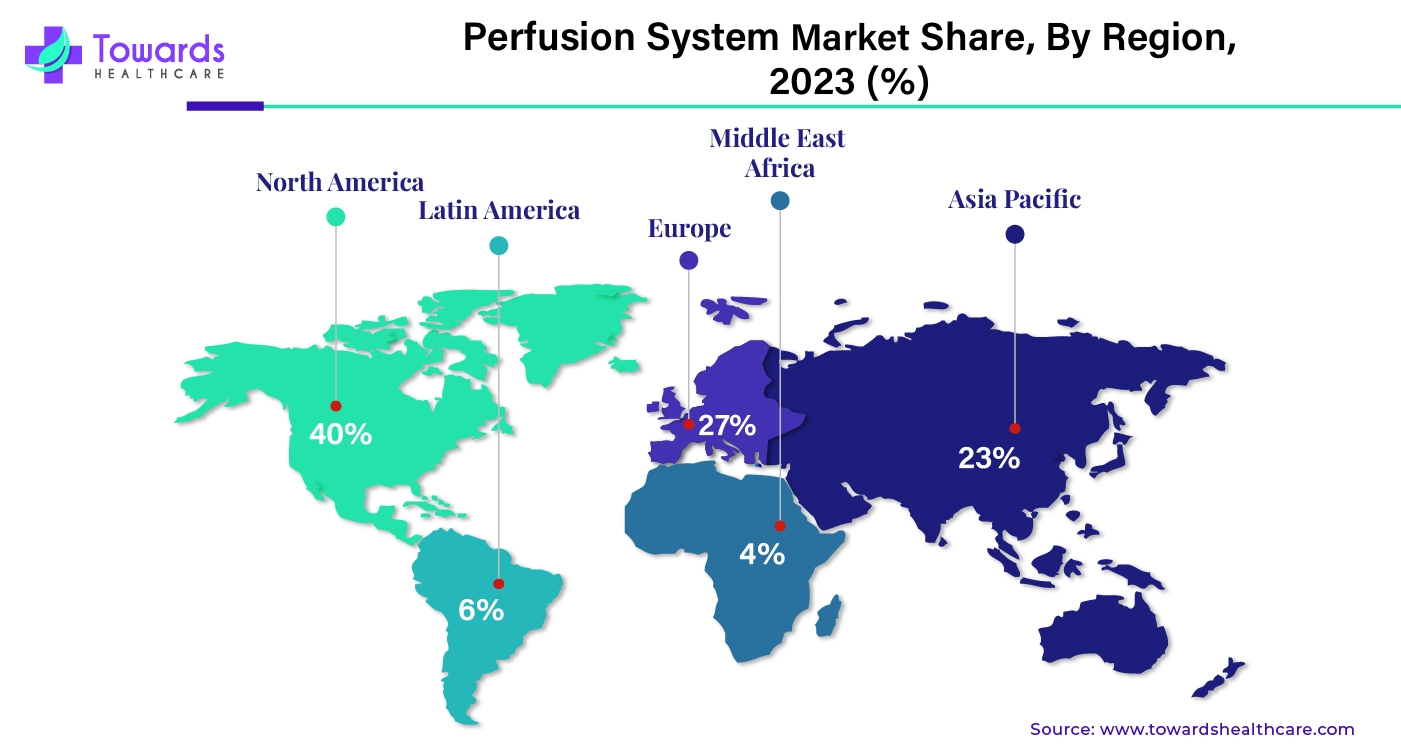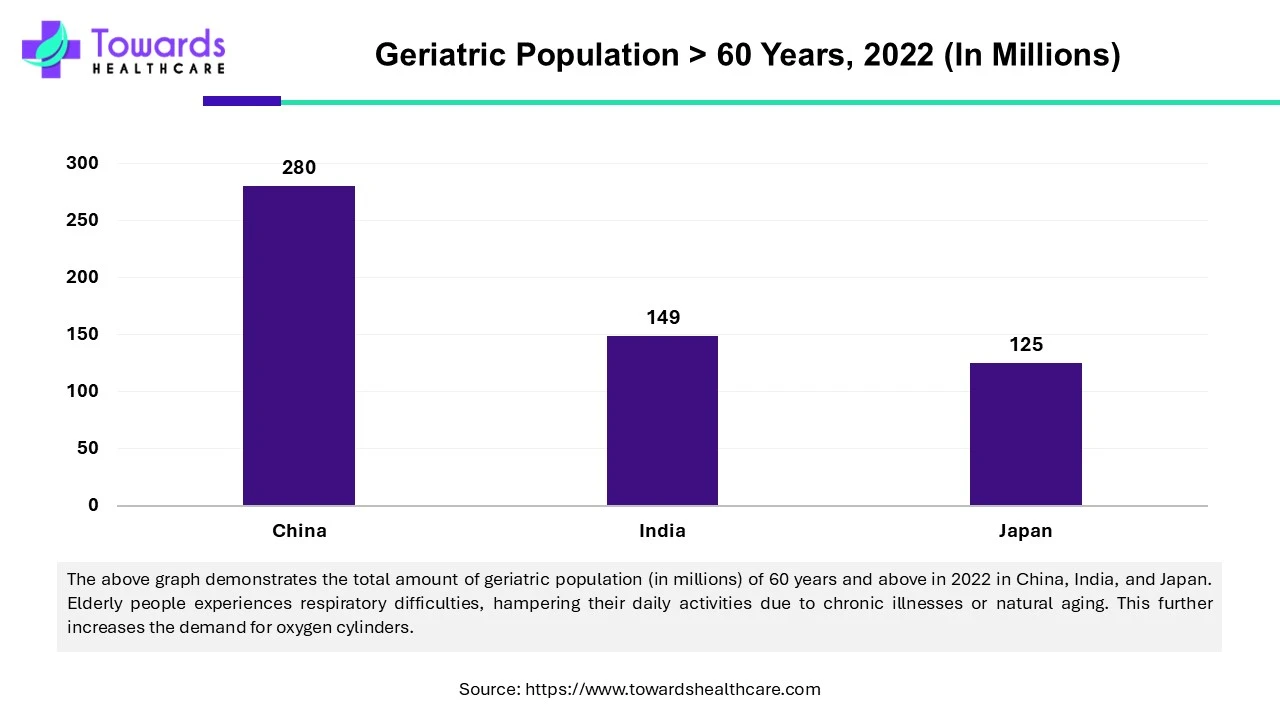April 2025

The perfusion systems market was estimated at US$ 1.15 billion in 2023 and is projected to grow to US$ 1.94 billion by 2034, rising at a compound annual growth rate (CAGR) of 4.85% from 2024 to 2034. The increasing incidence of cardiovascular, respiratory, and renal disorders and awareness of organ donation drive the perfusion systems market.

Perfusion is a process wherein the cells are cultured and kept fresh in a bioreactor with the help of a suitable culture medium. A fresh nutrient medium is incorporated, while cellular waste products are frequently removed from the medium. Depending on the type of operation, perfusion is classified into N-1 perfusion, concentrated fed-batch perfusion, intensified fed-batch perfusion, and continuous perfusion. The perfusion system is a specialized tool to extract single cells from isolated organs, including the liver, heart, and other organs of mice, rats, or guinea pigs. Using an enzyme solution to perfuse the tissue, the individual cells are released from their cellular framework and washed out. Perfusion systems are used to preserve donor cells/organs with the right temperature and nutrients outside the body for a desired amount of time.
Artificial intelligence (AI) and machine learning (ML) algorithms can be viable tools for improving patient outcomes. AI can play a vital role in the perfusion system by predicting the organ’s suitability for transplantation. AI has the potential to determine which organs would benefit from perfusion systems and which are unsuitable for donation. This can potentially reduce the chances of discarded organs and improve patient outcomes by predicting the correct organ for the recipient. Additionally, AI can assist in interpreting the vast amount of clinical data generated during the ex-vivo assessment of any organ. AI can aid in decision-making and predicting transplantation outcomes and organ utilization. AI can automate the perfusion process, providing high yields and consistent production during biomanufacturing.
| Company Name | LivaNova PLC |
| Headquarters | London, UK |
| Recent Development | In April 2024, LivaNova developed the Essenz Perfusion System to support open-heart surgery procedures in adult and pediatric patients. The system integrates the next-generation Heart-Lung machine (HLM) with an intuitive patient monitor and precise sensing technology for safe cardiopulmonary bypass management. |
| Company Name | Thermo Fisher Scientific |
| Headquarters | Waltham, Massachusetts, United States |
| Recent Development | In September 2022, Thermo Fisher Scientific developed a novel single-use bioreactor DynaDrive with better performance and scalability. The advanced features of the new bioreactor include superior mixing capabilities, mass transfer capabilities, and improved scalability. |
The rising chronic illnesses, including cardiovascular, respiratory, renal and hepatic disorders, lead to major surgeries involving organ transplantation. Perfusion systems are most commonly used for preserving organs like the heart, lungs, liver, and kidneys in a fresh nutrient medium before transplantation. Novel treatments involving perfusion fluids have the potential to reduce tissue damage, inhibit immune responses, and preserve cellular homeostasis. Technological advances in machine perfusion minimize the harm caused by static cold storage and provide tools for functional maintenance, restoration, and evaluation. The perfusion system allows organs to survive longer outside the body, and it assists doctors to better assess the quality and function of the organ before it is transplanted to the patient. Hence, the perfusion system can bridge the gap between supply and demand for transplant organs.
Despite numerous advantages, the perfusion system has several challenges. The high cost of the perfusion system limits the affordability of research institutions and transplant centers, especially in low- and middle-income countries. The average cost of the perfusion system in the US is around $456,455, whereas, in India, it is in the range of 11,000 INR to 18,00,000 INR. Additionally, there is a lack of skilled professionals to operate such complex equipment, which decreases its use. Furthermore, the complex nature of the process limits its development and scale-up of the perfusion system. This results in lower cell growth, cell density, and product quality.
The rapid growth of the biopharmaceutical sector has shown immense potential for the demand for the perfusion systems market. Approximately $48 billion is invested each year by the National Institute of Health. It has also been reported that the world’s top 20 pharmaceutical companies invested $145 billion in R&D in 2022-23. Perfusion systems are widely utilized in cell cultures to supply nutrients and remove waste products. There is tremendous demand for biopharmaceutical manufacturers to cut manufacturing costs and development timeframes, which necessitates the development of novel processing techniques.
Perfusion offers several advantages in the biopharma sector as the cells are regularly removed from the bioreactor, avoiding degradation, particularly for sensitive/labile biologics. Perfusion systems can be used in tissue engineering, stem cell engineering, and the manufacturing of cell culture-based products like vaccines, therapeutic proteins and antibodies, and cell therapy products. Hence, perfusion systems revolutionize the biopharma sector and have established their presence for many years to come.
By application, the cardiopulmonary perfusion system segment accounted for the largest share of the perfusion systems market in 2023. A cardiopulmonary perfusion system is a device that maintains the working of hearts and lungs during surgery. These products temporarily replace the functions of the heart and lungs during cardiac and thoracic surgery procedures. The different parts of cardiopulmonary perfusion systems include oxygenators, heart-lung machines, perfusion pumps, cannulas, and monitoring systems. The increasing incidences of cardiovascular and respiratory disorders boost the market growth. According to the National Heart, Lung, and Blood Institute, more than 2 million people globally have open-heart surgery every year to treat various heart problems. Coronary artery bypass grafting surgery is the world’s most common heart surgery. All these factors drive the market growth.
By application, the cell perfusion system segment is expected to grow at a significant rate in the perfusion systems market during the forecast period of 2024 to 2034. Cell perfusion system refers to attaining high cell densities and viabilities over extended periods. It utilizes a cell retention device and continuous media exchange. The cell retention device retains the cells in a bioreactor, and continuous media exchange favors replacing waste media with fresh nutrient media. The different types of cell perfusion systems include bioreactor perfusion systems, microfluidic perfusion systems, gravity/pressure-driven perfusion systems, and small mammal organ perfusion systems. These systems are widely used for live cell imaging, 3D cell culture, stem cell assays, drug screening, and toxicity tests.
By region, North America dominated the global perfusion systems market share by 40% in 2023. The rising incidences of end-stage cardiovascular, respiratory, renal, and hepatic disorders increase the need for transplantation surgeries among patients, which is responsible for driving the market growth. According to the United Network for Organ Sharing organization, more than 46,000 transplants were performed in the US in 2023. According to the Global Observatory on Donation and Transplantation, the US is the leading nation in organ transplantation. The market is also driven by increasing awareness, growing research and development, state-of-the-art healthcare infrastructures, and increasing investments.

By region, Asia-Pacific is projected to grow at a significant rate in the coming years. The increasing number of chronic disorders like cardiovascular and respiratory disorders, advanced healthcare infrastructure, and growing healthcare investments drive the perfusion systems market growth. The market is also driven by the government’s policies and initiatives for promoting organ donation. According to the National Organ and Tissue Transplant Organization report, there were 16,041 transplants in India in 2022. China and India rank second and third in the world in organ transplants. Additionally, the rising geriatric population in the Asia-Pacific region is a major concern.

In the graph, the large geriatric population indicates that the need for perfusion systems is high in Asia Pacific, and in the future, with the growing geriatric population, the demand is going to grow even further.
Europe also has the potential to augment the perfusion systems market during the forecast period. State-of-the-art research and development, rising chronic disorders, increased investments and collaborations, and advanced healthcare infrastructure drive market growth. The presence of key players and increasing demand for medical devices also drive the market growth in Europe. Countries like the UK, Germany, Spain, and France have increased demand for perfusion systems. Spain has the highest donation activity globally, with a rate of 48.9 donors per million people in 2023 and 122.1 per million transplant activity in 2023.
By Application
By Region
April 2025
April 2025
April 2025
April 2025